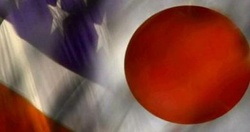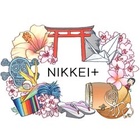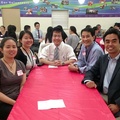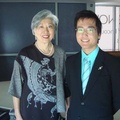At home, I speak Japanese. At school, I speak English. And at times, I speak both. The two languages are thrown in a verbal potpourri few can understand. I am a bilingual, fourth generation Japanese-American. But English is my favorite subject. As you can probably tell, my English and Japanese are often まざってる.1 いつも、 same sentenceで I use both languages.2 Upon typing the previous two sentences, I realized how confusing this concoction can be. It’s easy to hear, but definitely hard to read. Therefore, やるのを I’ll stop.3
By now, most are probably wondering how I am even fluent in speaking Japanese when I am a “fourth generation!” Japanese American. For one, it is never good to stereotype. For two, I learned from and speak a lot of Japanese with my Issei mother. For three, America mostly stops at the front door of my home. In other words, I was raised in a Japanesque home in an American neighborhood. In better words, I was confused.
When I was born, I had a Japanese middle name, American brand diapers, and Japanese clothes. Growing up, I watched 紅白歌合戦 (Kohaku Utagassen —Red and White Song Battle) on New Year’s Eve. But once it ended, there was just enough time to switch the channel to watch couples kissing as the sparkling New Year’s Eve ball drops over Times Square. The midnight of New Year’s Eve for those over 21 is celebrated with champagne and sake . The morning of the young New Year for all is met with my mother’s delicious osechi and ozoni while watching the Rose Parade on television. Unbeknownst to me every year until now, I had merged two disparate cultures in the process of aging. When I began noticing the fusion of language and customs, I became inclined to dig deeper into my family background. It was then I made a profound discovery.
With an Issei mother and Sansei father, I always wondered what -sei I was. It is simple to determine who or what someone else is. You give them categorical adjectives like “Asian”, “short”, or “clumsy”. According to some, I happen to be all three. However, when it comes to describing oneself, it is difficult. Who are we to what extent? Or what am I for which reason? I had no idea. It was not until my late childhood years that I determined my generation. That was when I learned of the terrible interruption in my grandparents’ life.
This is the story: Over a hundred years ago, my paternal great-grandparents sailed across the Pacific Ocean for the United States of America. They rooted themselves into the soil of the promise-land and bore children who similarly loved this country. All was well every year for many years until the war broke out between Japan and the United States. The blissful lives my grandparents had known were gone. The labor they provided for themselves and their community was all for naught. The fire of passion that kept them going was snuffed out by the heel of racism.
They were two of many who were incarcerated for their ethnicity, confined for their culture, maligned for their appearance, and shunned even while living in and loving the country they called home. Nothing good could ever come out of wars; for my grandparents, their wartime camp experience was defined by suffering, separation, and silence.
The story of my grandparents had a powerful effect on how I viewed my identity. My family past had long been written in America’s history book. Here was home. Thus, for me, I am not simply Japanese, American, or Japanese American; I was and will always be a Yonsei or fourth generation Japanese American. This designation itself represents intense pride in my ancestry and ancestral history in the United States. It is also a glorious testament to my success in deciphering what -sei I was.
Throughout the linguistic potpourri and cultural hodgepodge, being mixed-up is not so bamboozling after all. If there is enough will, there always is a way to rummage and “discover” the “Nikkei” inside all of us. And so, once more, as I have asked myself myriad times before: Who am I now? I say Yonsei.
Notes:
1. Translation: “As you can probably tell, my English and Japanese are often mixed-up.”
2. Translation: “I always use both languages in the same sentence.”
3. Translation: “Therefore, I’ll stop doing it.”
*This is one of the projects completed by The Nikkei Community Internship (NCI) Program intern each summer, which the Japanese American Bar Association and the Japanese American National Museum have co-hosted.
© 2013 Sean Hamamoto







